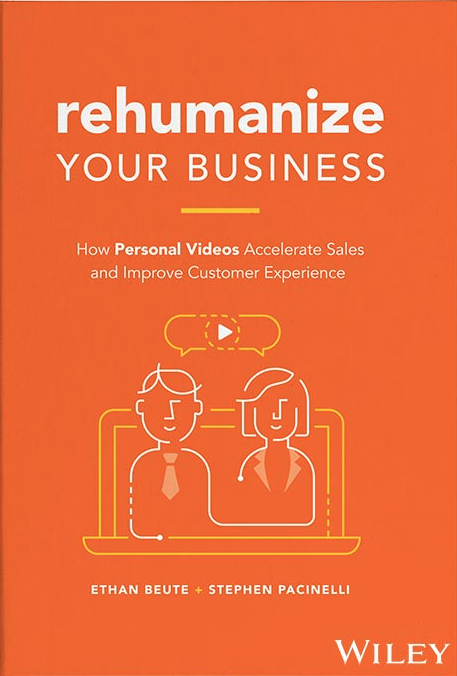INSIDER: Rehumanize Your Business
Maria Arauz, MBA
 Do you use email every day for work? Most of us do. Today, email is the standard method of business communication. However, when you are trying to reach new customers or close a deal, traditional emails do a poor job in getting across what makes you a great real estate agent. How can you overcome this problem? In Rehumanize Your Business: How Personal Videos Accelerate Sales and Improve Customer Experience, authors Ethan Beute and Steve Pacinelli present a solution: restoring a face-to-face element through personal video.
Do you use email every day for work? Most of us do. Today, email is the standard method of business communication. However, when you are trying to reach new customers or close a deal, traditional emails do a poor job in getting across what makes you a great real estate agent. How can you overcome this problem? In Rehumanize Your Business: How Personal Videos Accelerate Sales and Improve Customer Experience, authors Ethan Beute and Steve Pacinelli present a solution: restoring a face-to-face element through personal video.
Personal video refers to simple video you can use to reach out to customers—primarily via email, but also through texts and social media. These videos are not highly produced, polished marketing videos; rather, they are authentic, imperfect videos of yourself meant to create and cultivate relationships. Video allows customers to see and read your emotions, which helps build rapport and trust and makes you more approachable than if you sent a plain text message or email.
THINK POINT #1: How Personal Video Makes a Difference
Personal videos can be impactful. Sending videos results in significantly more and better responses, lead conversions, and referrals. In fact, authors Beute and Pacinelli explain that, according to a survey of 500 customers at BombBomb (a video email marketing platform), after sending at least 10 videos, 81% received more responses and 68% saw an increase in lead conversion.
Video makes a big difference because this movement is still very young. Imagine if you received a video in your inbox where you are greeted by name with a friendly smile and a wave. It is certainly out of the ordinary. It breaks a pattern, leading to increased attention and action. People do not expect to receive a personal video, and, when they do, they are surprised, delighted, and respond favorably. Video allows you to differentiate yourself by proving that you work differently and display a higher level of care.
Video also helps you better connect and persuade. Instead of hiding your personality and interpersonal skills behind a voicemail or email, you are showcasing these strengths when you use video. Like with face-to-face communication, with video you are able to communicate more clearly, influence more effectively, and convert at a higher rate because you become central to your message.
But… how time consuming is it to make these videos? You may be surprised to learn that it is almost always faster than sending an email. Because you do not have to worry about checking your grammar, looking for typos, and organizing your ideas to craft the perfect email that is not too pushy but still persuasive, hitting “Record” and talking to the other person through video is usually faster.
Personal videos are similar to voicemails in that they do not require a script and are simple and conversational. At the same time, people can play a video at their convenience, unlike when they receive a regular phone call, making video less intrusive and more respectful of their time. Markedly, video is superior to voicemail because it includes elements that cannot be delivered through faceless communication.
THINK POINT #2: The Right Time to Send a Personal Video
So, when is the right time to use video? The authors mention 10 situations that are ideal. Prospecting is one of them. As previously mentioned, video improves results by helping you differentiate, build trust, and catch the attention of the recipient. This is especially true when you are sending one-on-one videos, but it can also work with automated videos. If you cannot justify all custom sends due to volume or price, automated videos made for specific lead sources, such as when a person requests a quote, are an alternative. Even if true personal video is more effective, you are still leveraging relational benefits of video to generate a response.
Another instance that is ideal for sending video is to express gratitude. Seeing the words “thank you,” on an email is so common that their genuine tone is easily lost. In contrast, to say “thank you” with a smile, eye contact, and kind, spoken words brings back warm, human elements missing in text and, thus, conveys your sincere gratitude better. Expressing appreciation effectively is important because it helps establish, maintain, and advance relationships. A “thank you” video is, in fact, one of the easiest and highest value videos you can send.
There are eight other instances that are perfect for sending video, including to nurture leads and to share bad news or an apology. All of these situations benefit from the face-to-face element and convenience of video, which help build relationships better than faceless, digital messages. Video is a great method to incorporate in a healthy mix of communications as it humanizes and diversifies your touches.
THINK POINT #3: You Can Start Today
There are several ways you can start sending video emails: the screenshot method, the mobile method, and the pro method. All of these approaches have their pros and cons. For example, with the mobile method, video attachments will be large, but it is very convenient, since all you need is to record and send videos from your phone. The screenshot method, which involves embedding a screenshot of your video that links to your website or YouTube channel, is inexpensive but requires more steps, while the pro method, or hiring a third-party video management company, provides several benefits, including tracking and analytic capabilities, at a cost similar to that of traditional email marketing platforms.
 The bottom line, though, is that you can start sending video emails today with any of these approaches. You should start simple: pick one or two scenarios in which you commit to send a video email. For example, to say “thank you,” or if someone gives you a referral. As you send more of these types of videos, you will get better, gain more confidence, learn what works, and refine your approach, eventually being able to add other scenarios, one at a time. This deliberate execution will help you get started and grow naturally.
The bottom line, though, is that you can start sending video emails today with any of these approaches. You should start simple: pick one or two scenarios in which you commit to send a video email. For example, to say “thank you,” or if someone gives you a referral. As you send more of these types of videos, you will get better, gain more confidence, learn what works, and refine your approach, eventually being able to add other scenarios, one at a time. This deliberate execution will help you get started and grow naturally.
As you get started, remember that these videos don’t have to be perfect. In real conversations, you don’t get do-overs. Video should be similar. The more authentic your video is, the more you add a human quality to your message and the better you will be able to connect.
Conclusion
As authors Beute and Pacinelli’s put it, “We’ve relied too long on faceless digital communication to get important and valuable jobs done.” Video is a great alternative that adds back human elements to your message and helps improve your work communications and results. Rehumanize Your Business: How Personal Videos Accelerate Sales and Improve Customer Experience is an excellent guide on how to start using personal video to do just that. If you are already using video, this book is also a great resource to learn best practice and ways to further improve your opens, plays, and replies. In short, Beute and Pacinelli’s book is a useful read filled with anecdotes and lessons to help you make the most of video in your everyday communications.
. . . . . . . . . . . . . . . . . . .
Recommended Reading
Beute, Ethan and Stephen Pacinelli (2019), Rehumanize Your Business: How Personal Videos Accelerate Sales and Improve Customer Experience, Wiley.
. . . . . . . . . . . . . . . . . . .
About the Author
Maria Arauz, MBA
Baylor University
Maria Arauz earned her Bachelor of Science in Business Administration from Towson University and her MBA from Baylor University. Before beginning graduate school, Maria served in roles for corporations such as Procter & Gamble and Dell. She is currently a Project Manager at Dell.